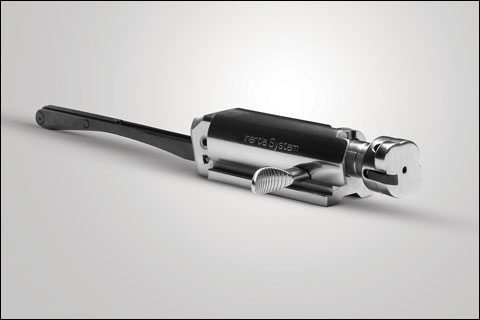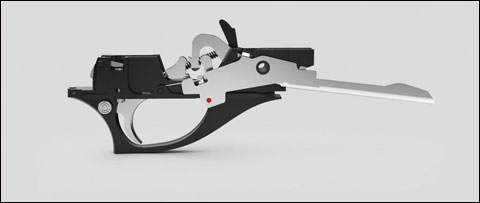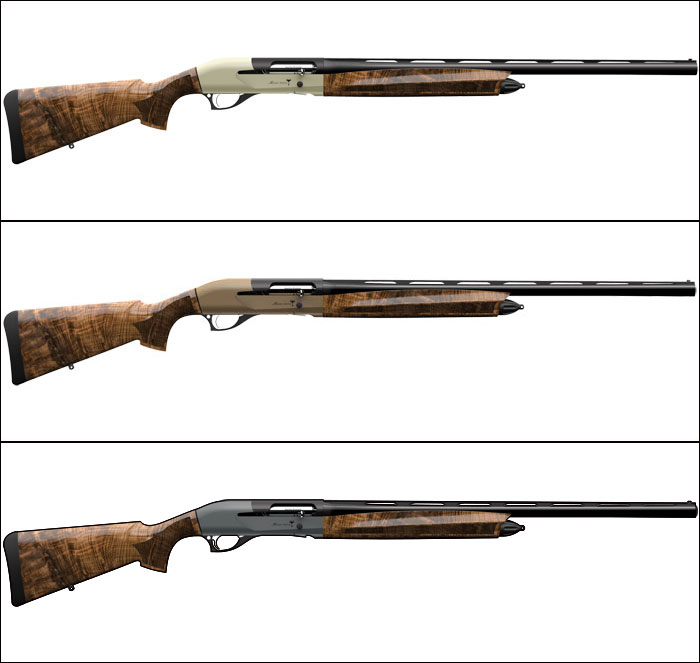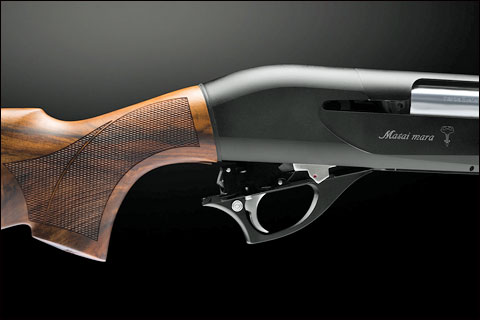The Retay Masai Mara Semi-Auto One-Ups Benelli’s Inertia Drive at About Half the Price

Spanish gun makers established their reputations for quality and value by replicating England’s best guns for a fraction of the price. Now Retay Arms of Konya Turkey has taken a cue from Spain by manufacturing the Masai Mara semi-auto with an upgraded inertia-action adopted from Benelli shotguns, but retails for about half.
Retay was founded in 2006, the year Benelli’s inertia-drive patent expired. Benelli had originally purchased the patent in 1967 from engineer Bruno Civolani and subsequently parlayed the breakthough into perhaps the most successful semi-auto shotgun franchise in history. Mr. Civolani’s ingenuity relied on the weight of the bolt carrier, coupled with a strong spring in the carrier mechanism, to rotate the bolt head and cycle the action after each shot.
The Civolani inertia design popularized a semi-automatic with fewer moving parts than the gas-powered counterparts and in turn improved reliability.

Retay’s patented Inertia Plus System bolt used in their Masai Mara semi-auto.
The simplicity of Benelli’s recoil-driven inertia-action set the benchmark for dependability against the gas-powered semi-automatic shotguns that were storming the market. Benellis became the go-to shotgun for the harsh environments of waterfowl hunting. Still, the Benelli owners dreaded the so-called “Benelli click” that signaled an out-of-battery floating bolt head. When the bolt dislocated, the hammer would strike the back of it instead of the firing pin: misfire. The problem wasn’t fatal to the gun, but did cost birds (and time).
Come June 12, 2018, Retay received U.S. patent 9,995,542 for its “Rotating head assembly for use with the bolt assembly of a gun.” The patent was the culmination of research and development at Retay to prevent unintended dislocation of the bolt head – in effect fixing the “Benelli click.”
Retay’s proprietary design forced the floating bolt head in place through a supplemental internal bolt spring that increased rotational force to maintain alignment – even when the gun is dropped.
After trigging the shot, kinetic energy from the recoil is stored momentarily within the bolt body as it moves backwards. When the bolt starts to recover and cycle the second shot, the spring-driven torsion mechanism within the bolt releases the stored kinetic energy to apply additional forward rotational force that helps lock it securely into battery, ensuring the next shot.
Retay trademarked their action the Inertia Plus System.

Retay’s headquarters in Konya Turkey.
Next step for Retay was introducing the Masai Mara to American wing and clays shooters. About two years ago the company tapped Christian Handy, owner of fine gun lifestyle enterprise, Thomas Ferney & Co. in Darnestown, Maryland, to serve as their U.S. operations under the new organization, Retay USA. Thomas Ferney outfits sportsmen and women with world-class shotguns and accessories such as vintage-inspired gun cases, range bags and travel gear designed in-house to reflect a sophisticated sporting style.
“We handle Retay’s U.S. marketing and distribution,” Mr. Handy explained.
He’s in the process of building an American dealer network, with about 50 secured so far, through distributors Bill Hicks & Co. and Connecticut Shotgun Manufacturing Company.

The Masai Mara detachable trigger group.
The Masai Mara made its American debut in January of 2018 at the SHOT Show in Las Vegas – showcasing a bevy of features that sweetened the competitive price. Most prominent were its push-button detachable trigger group and grade-three, oil-finished Turkish walnut stock and forend that are checkered and finished in Italy (and not ink-injected to enhance marbling as adopted by many mid-priced shotgun manufactures).
The aerospace grade aluminum alloy receiver was available in three shades of black, two camo, satin silver and satin bronze and could be fitted with a black synthetic stock. Retay installed a molded ergonomic high density micro-cell polyurethane recoil pad. Shims for adjusting cast and drop were included.

Some of the receiver finishes available for the Masi Mara semi-auto include Satin, Bronze and Grey.
The Masai Mara barrel was drilled from Austrian Bohler steel, chrome lined and optimized with an elongated 2.5% degree forcing cone. Atop the barrel was an 8mm vented sight rib and TruGlo front bead. Barrel finish options included matte or polished black chrome in lengths of 24 inches, 26 inches, 28 inches or 30 inches. The three-inch chambers are capable of cycling 12-gauge loads of just about any size.
An oversized shell elevator and beveled loading port facilitated fast reloading of the 4+1 tube magazine. A generous trigger guard was milled from solid billet aluminum rather than plastic.
Five flush Retay chokes were standard: cylinder, improved cylinder, modified, improved modified and full. Overall, the Masai Mara weighed a well-balanced 6¾ pounds, and with integrated sling swivels should be easy to carry in the field.

The grade three oil-finished Turkish walnut stock of the Masai Mara semi-auto.
Although the camo-adorned Masai Maras cost $949.00, the other finishes have a suggested retail price of $1,095 or about 50 percent less than the upmarket, comparably equipped Benelli Ethos.
The SHOT Show introduction was quickly followed by an announcement in February 2018 with Briley Manufacturing. Briley established the Retay Warranty Center in its Houston, Texas facility. Briley would maintain an onsite inventory of over 2,000 replacement parts for Masai Mara to cover the shotgun under its five-year warranty or for general repairs.
Shooting sporting clays with the Retay Masai Mara drives home a fundamental reminder: unlike gas-powered semi-autos or break-open shotguns you must place the stock butt firmly in the shoulder pocket for an inertia-driven semi-auto to cycle. Unless you’re an exhibition shooter with a tricked-out special, inertia semi-autos demand a dead stop (against your shoulder) to advance a shell into the chamber.

The Masi Mara semi-auto with Matte Black receiver showing the push-button drop-out trigger group.
The Retay Masi Mara delivered to us had the polished black receiver with a swoopy matte black inset. Complimented by a shapely forend that flared toward mid-barrel before curving down to the black conical forend cap, the shotgun exuded modern Italian elegance enriched by the oil-finished smoky figuring of the walnut. The chrome black barrel (rated for steel shot) ran 28 inches. A safety switch resided in the sleek matte black trigger guard. But even new-school design fans might gripe about the small bolt release button in the receiver.
The beauty of handling an inertia-driven semi-autos is their prevailing balance. Without the apparatus of gas cylinder, piston, spring and valves under the forend of gas-powered semi-autos, Retay’s Masi Mara proved lightning quick while neutral to mount and swing, more in the spirit of a 20 gauge than the 12 gauge in hand.
At the sporting clays course, the grass around a rabbit target hadn’t been cut in a while, and so I waited for a fleeting window of visibility to stab at the target and break it – the quick trigger a responsive 5¼ pounds.
Once you get into the groove with the Retay Masai Mara the shooting rhythm quickly picks up and you’re able to blow-up targets much faster than perhaps you initially thought. You simply build faith in the shotgun’s nimble handling, flat point of impact and precision trigger.
Right now, as with all new shotgun models, long-term durability of the Masi Mara remains to be determined. Retay’s corporate mission is “to set a new standard of excellence in the Turkish firearms industry.” Until sometime down the road enthusiasts tell us otherwise, the new Retay Masai Mara appears to be a great deal for its sleek packaging of innovation.
Irwin Greenstein is the publisher of Shotgun Life. You can reach him at contact@shotgunlife.com.
Useful resources:

Irwin Greenstein is Publisher of Shotgun Life. Please send your comments to letters@shotgunlife.com.


Comments